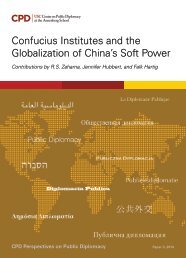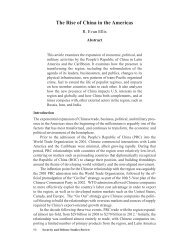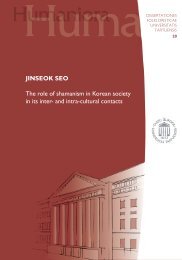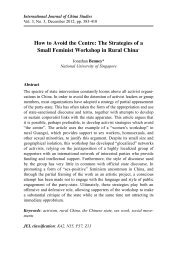JennyChan.PhDThesis.2014.FINAL
JennyChan.PhDThesis.2014.FINAL
JennyChan.PhDThesis.2014.FINAL
Create successful ePaper yourself
Turn your PDF publications into a flip-book with our unique Google optimized e-Paper software.
and visual recording was not allowed, I wrote fieldnotes immediately following the<br />
trials. Moreover, between 2013 and the first quarter of 2014, I conducted follow-up<br />
interviews with worker activists involved in riots, strikes and/or protests at Foxconn<br />
factories based in Shenzhen, Chengdu (provincial capital of Sichuan), Zhengzhou<br />
(provincial capital of Henan), Wuhan (provincial capital of Hubei), and Taiyuan (a<br />
fast-growing city in Shanxi). I paid attention to the causes of labor discontents and<br />
the settlements and outcomes of the collective actions.<br />
In addition to the key informants from the enterprise and vocational schools, I<br />
interviewed six local government officials at Longhua town (Shenzhen) and<br />
Hongguang and Pitong towns (both are in Chengdu) to better understand the<br />
collaboration between business and local states. The officials shared with me policies<br />
about employment and social services, economic development, labor recruitment, and<br />
above all school-business joint educational programs. 57 Indeed, the provincial and<br />
lower-level governments actively intervened in the labor market to facilitate<br />
corporate expansion. At government buildings, administrators assisted walk-in job<br />
applicants to prepare interviews at Foxconn and other private enterprises. Some<br />
administrators also set up recruitment counters outside the Chengdu railway station<br />
to help Foxconn’s hiring. Others issued directives to schools to fulfill internship<br />
requirements at companies under their jurisdiction. Through a snowball sampling, I<br />
had opportunities to talk to student interns, teachers, and managers who implemented<br />
the internship plan at Foxconn factories.<br />
Finally, on 16 December 2013, in my dual role as an independent researcher and a<br />
nonprofit labor organization advisor, 58 I wrote to the chief executives of Foxconn<br />
(Terry Gou) and Apple (Tim Cook) to express concerns about working hours, wages<br />
and benefits, student interns, worker safety, and union organization at the<br />
supplier-factory level. 59 On 31 December 2013, I received a reply from a Foxconn<br />
representative, Dr. Martin Hsing, Executive Director of Global Social and<br />
Environmental Responsibility Committee. 60 On 18 February 2014, I also heard from<br />
Ms. Jacky Haynes, Senior Director of Apple’s Supplier Responsibility Program, 61<br />
together with the enclosed 40-page 2014 Progress Report. In the following chapters I<br />
present the company statements as appropriate.<br />
57 Xiaoqi hezuo ( 校 企 合合 作 ).<br />
58 That is, my advisory role with Hong Kong-based SACOM (Students and Scholars Against<br />
Corporate Misbehavior).<br />
59 Professors Pun Ngai and Mark Selden are co-researchers, whose deep engagement in Foxconn<br />
labor research has had a lasting impact on my academic studies and outreach to the two companies.<br />
60 The 7-page Foxconn statement (31 December 2013), in English, is on file.<br />
61 The 1,500-word Apple response in email correspondence (18 February 2014) is on file.<br />
18






